Tesco Plc's International HRM Strategy for Bangladesh Operations
VerifiedAdded on 2020/05/28
|25
|6254
|1127
Report
AI Summary
This report examines the human resource strategy that Tesco Plc should adopt when entering the Bangladesh market. It begins by highlighting the historical evolution of HRM, differentiating between hard and soft HRM approaches, and outlining the organization's profile. The report then analyzes the retail sector in Bangladesh, including industry drivers, the host country's profile, and a PESTLE analysis. It explores the economic and political factors influencing the business environment. The core of the report focuses on Tesco's HRM strategy, including recruitment, training and development, reward management, performance management, and employee involvement. It also provides recommendations for Tesco's HRM policy in the new market. The study emphasizes the importance of employee engagement and adapting HRM strategies to the local context to ensure success in the competitive retail landscape of Bangladesh.
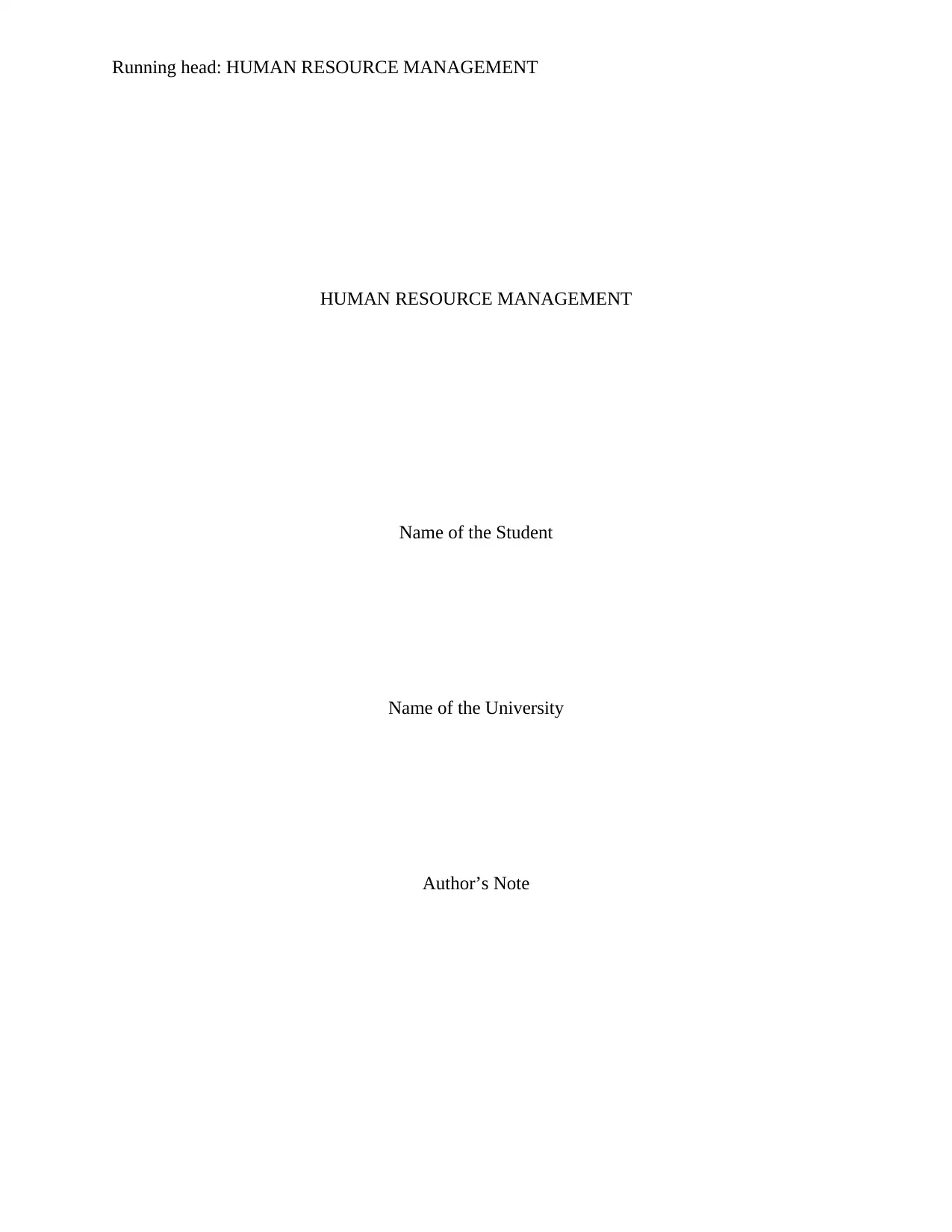
Running head: HUMAN RESOURCE MANAGEMENT
HUMAN RESOURCE MANAGEMENT
Name of the Student
Name of the University
Author’s Note
HUMAN RESOURCE MANAGEMENT
Name of the Student
Name of the University
Author’s Note
Paraphrase This Document
Need a fresh take? Get an instant paraphrase of this document with our AI Paraphraser
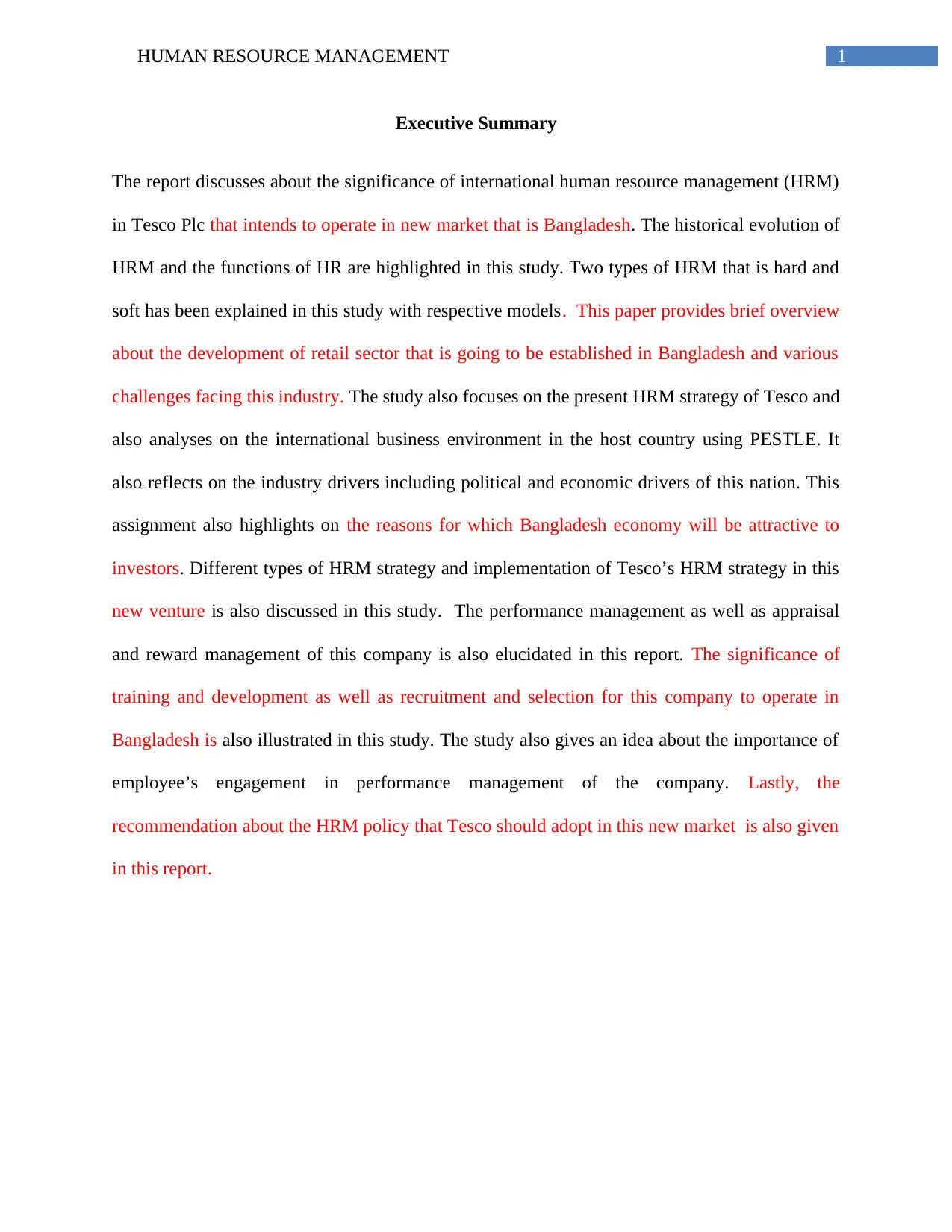
1HUMAN RESOURCE MANAGEMENT
Executive Summary
The report discusses about the significance of international human resource management (HRM)
in Tesco Plc that intends to operate in new market that is Bangladesh. The historical evolution of
HRM and the functions of HR are highlighted in this study. Two types of HRM that is hard and
soft has been explained in this study with respective models. This paper provides brief overview
about the development of retail sector that is going to be established in Bangladesh and various
challenges facing this industry. The study also focuses on the present HRM strategy of Tesco and
also analyses on the international business environment in the host country using PESTLE. It
also reflects on the industry drivers including political and economic drivers of this nation. This
assignment also highlights on the reasons for which Bangladesh economy will be attractive to
investors. Different types of HRM strategy and implementation of Tesco’s HRM strategy in this
new venture is also discussed in this study. The performance management as well as appraisal
and reward management of this company is also elucidated in this report. The significance of
training and development as well as recruitment and selection for this company to operate in
Bangladesh is also illustrated in this study. The study also gives an idea about the importance of
employee’s engagement in performance management of the company. Lastly, the
recommendation about the HRM policy that Tesco should adopt in this new market is also given
in this report.
Executive Summary
The report discusses about the significance of international human resource management (HRM)
in Tesco Plc that intends to operate in new market that is Bangladesh. The historical evolution of
HRM and the functions of HR are highlighted in this study. Two types of HRM that is hard and
soft has been explained in this study with respective models. This paper provides brief overview
about the development of retail sector that is going to be established in Bangladesh and various
challenges facing this industry. The study also focuses on the present HRM strategy of Tesco and
also analyses on the international business environment in the host country using PESTLE. It
also reflects on the industry drivers including political and economic drivers of this nation. This
assignment also highlights on the reasons for which Bangladesh economy will be attractive to
investors. Different types of HRM strategy and implementation of Tesco’s HRM strategy in this
new venture is also discussed in this study. The performance management as well as appraisal
and reward management of this company is also elucidated in this report. The significance of
training and development as well as recruitment and selection for this company to operate in
Bangladesh is also illustrated in this study. The study also gives an idea about the importance of
employee’s engagement in performance management of the company. Lastly, the
recommendation about the HRM policy that Tesco should adopt in this new market is also given
in this report.
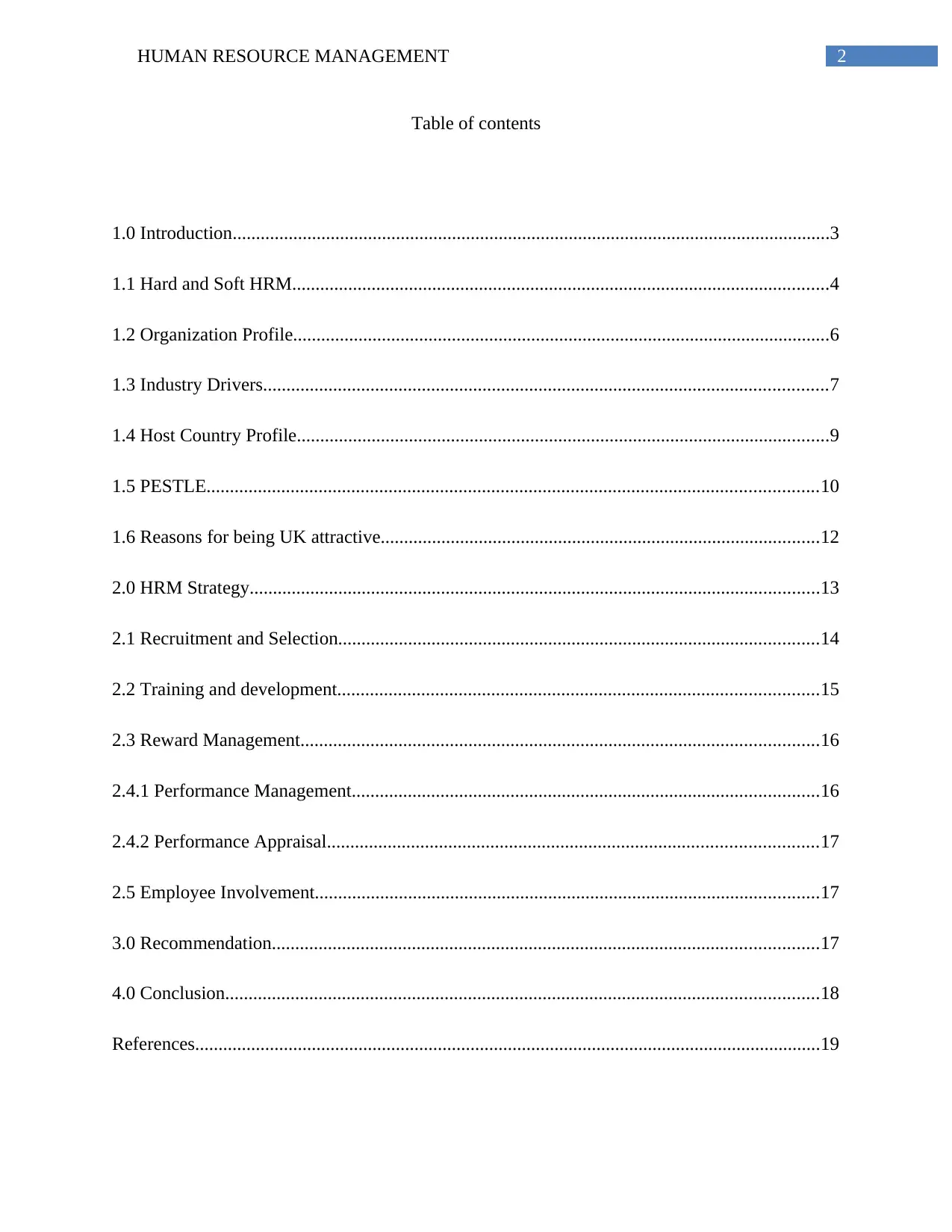
2HUMAN RESOURCE MANAGEMENT
Table of contents
1.0 Introduction................................................................................................................................3
1.1 Hard and Soft HRM...................................................................................................................4
1.2 Organization Profile...................................................................................................................6
1.3 Industry Drivers.........................................................................................................................7
1.4 Host Country Profile..................................................................................................................9
1.5 PESTLE...................................................................................................................................10
1.6 Reasons for being UK attractive..............................................................................................12
2.0 HRM Strategy..........................................................................................................................13
2.1 Recruitment and Selection.......................................................................................................14
2.2 Training and development.......................................................................................................15
2.3 Reward Management...............................................................................................................16
2.4.1 Performance Management....................................................................................................16
2.4.2 Performance Appraisal.........................................................................................................17
2.5 Employee Involvement............................................................................................................17
3.0 Recommendation.....................................................................................................................17
4.0 Conclusion...............................................................................................................................18
References......................................................................................................................................19
Table of contents
1.0 Introduction................................................................................................................................3
1.1 Hard and Soft HRM...................................................................................................................4
1.2 Organization Profile...................................................................................................................6
1.3 Industry Drivers.........................................................................................................................7
1.4 Host Country Profile..................................................................................................................9
1.5 PESTLE...................................................................................................................................10
1.6 Reasons for being UK attractive..............................................................................................12
2.0 HRM Strategy..........................................................................................................................13
2.1 Recruitment and Selection.......................................................................................................14
2.2 Training and development.......................................................................................................15
2.3 Reward Management...............................................................................................................16
2.4.1 Performance Management....................................................................................................16
2.4.2 Performance Appraisal.........................................................................................................17
2.5 Employee Involvement............................................................................................................17
3.0 Recommendation.....................................................................................................................17
4.0 Conclusion...............................................................................................................................18
References......................................................................................................................................19
⊘ This is a preview!⊘
Do you want full access?
Subscribe today to unlock all pages.

Trusted by 1+ million students worldwide
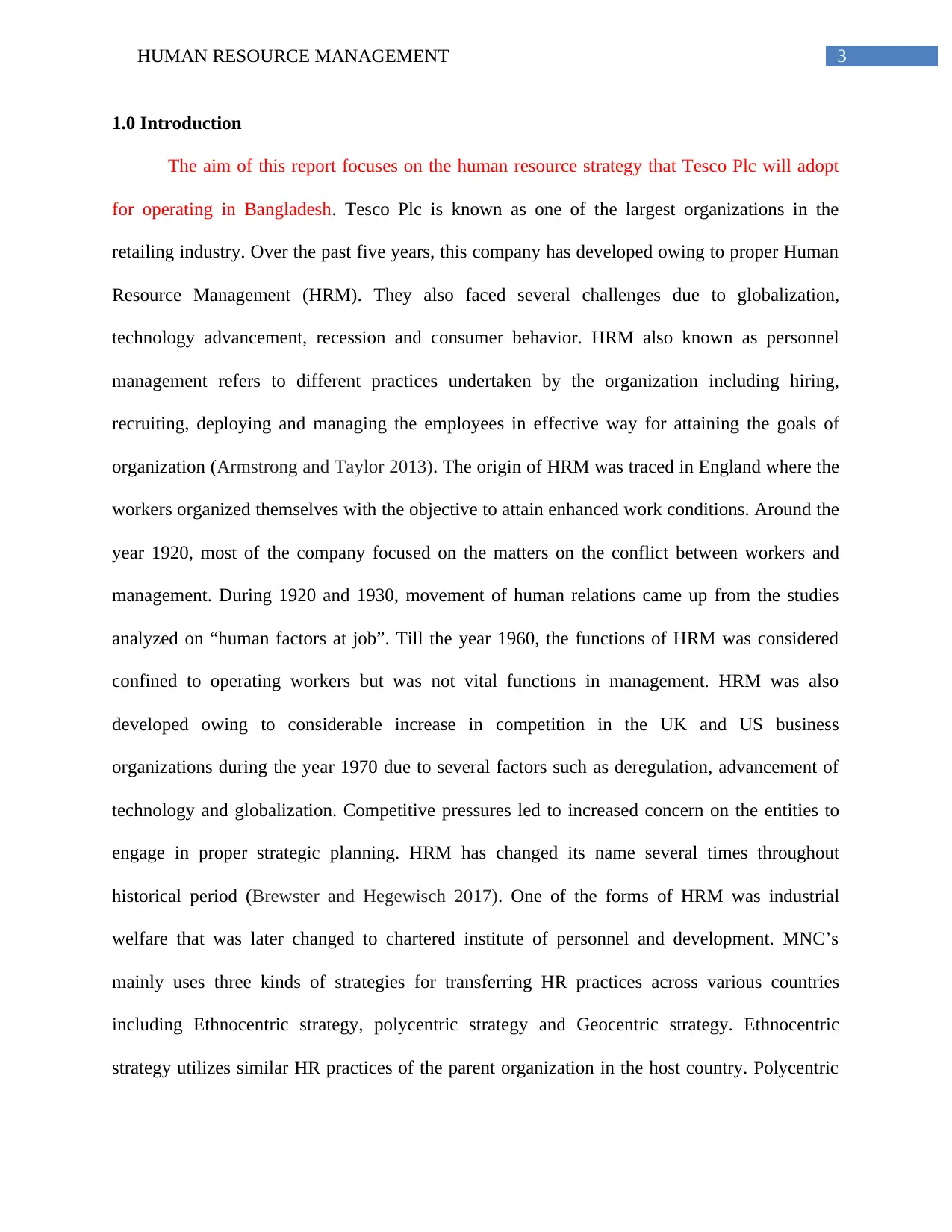
3HUMAN RESOURCE MANAGEMENT
1.0 Introduction
The aim of this report focuses on the human resource strategy that Tesco Plc will adopt
for operating in Bangladesh. Tesco Plc is known as one of the largest organizations in the
retailing industry. Over the past five years, this company has developed owing to proper Human
Resource Management (HRM). They also faced several challenges due to globalization,
technology advancement, recession and consumer behavior. HRM also known as personnel
management refers to different practices undertaken by the organization including hiring,
recruiting, deploying and managing the employees in effective way for attaining the goals of
organization (Armstrong and Taylor 2013). The origin of HRM was traced in England where the
workers organized themselves with the objective to attain enhanced work conditions. Around the
year 1920, most of the company focused on the matters on the conflict between workers and
management. During 1920 and 1930, movement of human relations came up from the studies
analyzed on “human factors at job”. Till the year 1960, the functions of HRM was considered
confined to operating workers but was not vital functions in management. HRM was also
developed owing to considerable increase in competition in the UK and US business
organizations during the year 1970 due to several factors such as deregulation, advancement of
technology and globalization. Competitive pressures led to increased concern on the entities to
engage in proper strategic planning. HRM has changed its name several times throughout
historical period (Brewster and Hegewisch 2017). One of the forms of HRM was industrial
welfare that was later changed to chartered institute of personnel and development. MNC’s
mainly uses three kinds of strategies for transferring HR practices across various countries
including Ethnocentric strategy, polycentric strategy and Geocentric strategy. Ethnocentric
strategy utilizes similar HR practices of the parent organization in the host country. Polycentric
1.0 Introduction
The aim of this report focuses on the human resource strategy that Tesco Plc will adopt
for operating in Bangladesh. Tesco Plc is known as one of the largest organizations in the
retailing industry. Over the past five years, this company has developed owing to proper Human
Resource Management (HRM). They also faced several challenges due to globalization,
technology advancement, recession and consumer behavior. HRM also known as personnel
management refers to different practices undertaken by the organization including hiring,
recruiting, deploying and managing the employees in effective way for attaining the goals of
organization (Armstrong and Taylor 2013). The origin of HRM was traced in England where the
workers organized themselves with the objective to attain enhanced work conditions. Around the
year 1920, most of the company focused on the matters on the conflict between workers and
management. During 1920 and 1930, movement of human relations came up from the studies
analyzed on “human factors at job”. Till the year 1960, the functions of HRM was considered
confined to operating workers but was not vital functions in management. HRM was also
developed owing to considerable increase in competition in the UK and US business
organizations during the year 1970 due to several factors such as deregulation, advancement of
technology and globalization. Competitive pressures led to increased concern on the entities to
engage in proper strategic planning. HRM has changed its name several times throughout
historical period (Brewster and Hegewisch 2017). One of the forms of HRM was industrial
welfare that was later changed to chartered institute of personnel and development. MNC’s
mainly uses three kinds of strategies for transferring HR practices across various countries
including Ethnocentric strategy, polycentric strategy and Geocentric strategy. Ethnocentric
strategy utilizes similar HR practices of the parent organization in the host country. Polycentric
Paraphrase This Document
Need a fresh take? Get an instant paraphrase of this document with our AI Paraphraser
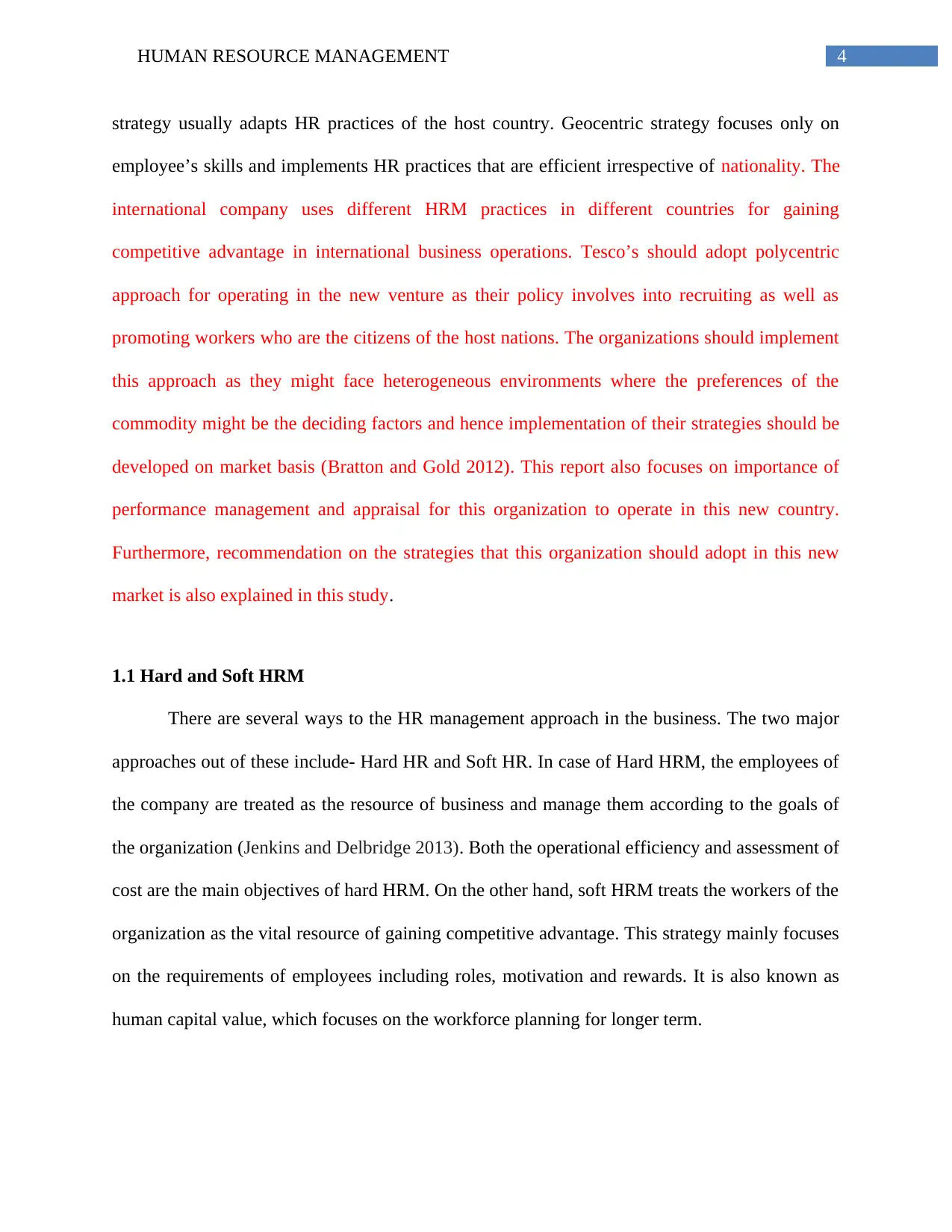
4HUMAN RESOURCE MANAGEMENT
strategy usually adapts HR practices of the host country. Geocentric strategy focuses only on
employee’s skills and implements HR practices that are efficient irrespective of nationality. The
international company uses different HRM practices in different countries for gaining
competitive advantage in international business operations. Tesco’s should adopt polycentric
approach for operating in the new venture as their policy involves into recruiting as well as
promoting workers who are the citizens of the host nations. The organizations should implement
this approach as they might face heterogeneous environments where the preferences of the
commodity might be the deciding factors and hence implementation of their strategies should be
developed on market basis (Bratton and Gold 2012). This report also focuses on importance of
performance management and appraisal for this organization to operate in this new country.
Furthermore, recommendation on the strategies that this organization should adopt in this new
market is also explained in this study.
1.1 Hard and Soft HRM
There are several ways to the HR management approach in the business. The two major
approaches out of these include- Hard HR and Soft HR. In case of Hard HRM, the employees of
the company are treated as the resource of business and manage them according to the goals of
the organization (Jenkins and Delbridge 2013). Both the operational efficiency and assessment of
cost are the main objectives of hard HRM. On the other hand, soft HRM treats the workers of the
organization as the vital resource of gaining competitive advantage. This strategy mainly focuses
on the requirements of employees including roles, motivation and rewards. It is also known as
human capital value, which focuses on the workforce planning for longer term.
strategy usually adapts HR practices of the host country. Geocentric strategy focuses only on
employee’s skills and implements HR practices that are efficient irrespective of nationality. The
international company uses different HRM practices in different countries for gaining
competitive advantage in international business operations. Tesco’s should adopt polycentric
approach for operating in the new venture as their policy involves into recruiting as well as
promoting workers who are the citizens of the host nations. The organizations should implement
this approach as they might face heterogeneous environments where the preferences of the
commodity might be the deciding factors and hence implementation of their strategies should be
developed on market basis (Bratton and Gold 2012). This report also focuses on importance of
performance management and appraisal for this organization to operate in this new country.
Furthermore, recommendation on the strategies that this organization should adopt in this new
market is also explained in this study.
1.1 Hard and Soft HRM
There are several ways to the HR management approach in the business. The two major
approaches out of these include- Hard HR and Soft HR. In case of Hard HRM, the employees of
the company are treated as the resource of business and manage them according to the goals of
the organization (Jenkins and Delbridge 2013). Both the operational efficiency and assessment of
cost are the main objectives of hard HRM. On the other hand, soft HRM treats the workers of the
organization as the vital resource of gaining competitive advantage. This strategy mainly focuses
on the requirements of employees including roles, motivation and rewards. It is also known as
human capital value, which focuses on the workforce planning for longer term.
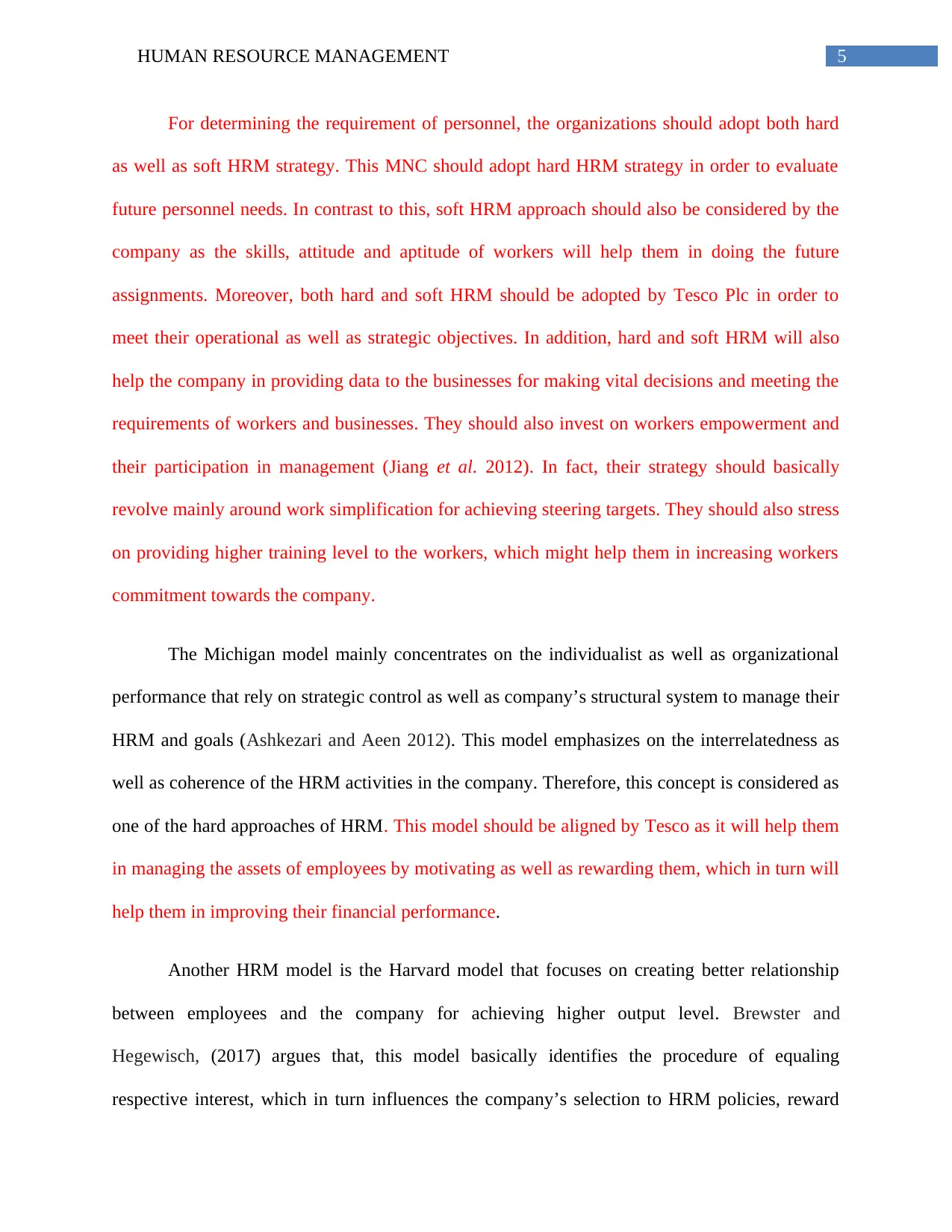
5HUMAN RESOURCE MANAGEMENT
For determining the requirement of personnel, the organizations should adopt both hard
as well as soft HRM strategy. This MNC should adopt hard HRM strategy in order to evaluate
future personnel needs. In contrast to this, soft HRM approach should also be considered by the
company as the skills, attitude and aptitude of workers will help them in doing the future
assignments. Moreover, both hard and soft HRM should be adopted by Tesco Plc in order to
meet their operational as well as strategic objectives. In addition, hard and soft HRM will also
help the company in providing data to the businesses for making vital decisions and meeting the
requirements of workers and businesses. They should also invest on workers empowerment and
their participation in management (Jiang et al. 2012). In fact, their strategy should basically
revolve mainly around work simplification for achieving steering targets. They should also stress
on providing higher training level to the workers, which might help them in increasing workers
commitment towards the company.
The Michigan model mainly concentrates on the individualist as well as organizational
performance that rely on strategic control as well as company’s structural system to manage their
HRM and goals (Ashkezari and Aeen 2012). This model emphasizes on the interrelatedness as
well as coherence of the HRM activities in the company. Therefore, this concept is considered as
one of the hard approaches of HRM. This model should be aligned by Tesco as it will help them
in managing the assets of employees by motivating as well as rewarding them, which in turn will
help them in improving their financial performance.
Another HRM model is the Harvard model that focuses on creating better relationship
between employees and the company for achieving higher output level. Brewster and
Hegewisch, (2017) argues that, this model basically identifies the procedure of equaling
respective interest, which in turn influences the company’s selection to HRM policies, reward
For determining the requirement of personnel, the organizations should adopt both hard
as well as soft HRM strategy. This MNC should adopt hard HRM strategy in order to evaluate
future personnel needs. In contrast to this, soft HRM approach should also be considered by the
company as the skills, attitude and aptitude of workers will help them in doing the future
assignments. Moreover, both hard and soft HRM should be adopted by Tesco Plc in order to
meet their operational as well as strategic objectives. In addition, hard and soft HRM will also
help the company in providing data to the businesses for making vital decisions and meeting the
requirements of workers and businesses. They should also invest on workers empowerment and
their participation in management (Jiang et al. 2012). In fact, their strategy should basically
revolve mainly around work simplification for achieving steering targets. They should also stress
on providing higher training level to the workers, which might help them in increasing workers
commitment towards the company.
The Michigan model mainly concentrates on the individualist as well as organizational
performance that rely on strategic control as well as company’s structural system to manage their
HRM and goals (Ashkezari and Aeen 2012). This model emphasizes on the interrelatedness as
well as coherence of the HRM activities in the company. Therefore, this concept is considered as
one of the hard approaches of HRM. This model should be aligned by Tesco as it will help them
in managing the assets of employees by motivating as well as rewarding them, which in turn will
help them in improving their financial performance.
Another HRM model is the Harvard model that focuses on creating better relationship
between employees and the company for achieving higher output level. Brewster and
Hegewisch, (2017) argues that, this model basically identifies the procedure of equaling
respective interest, which in turn influences the company’s selection to HRM policies, reward
⊘ This is a preview!⊘
Do you want full access?
Subscribe today to unlock all pages.

Trusted by 1+ million students worldwide
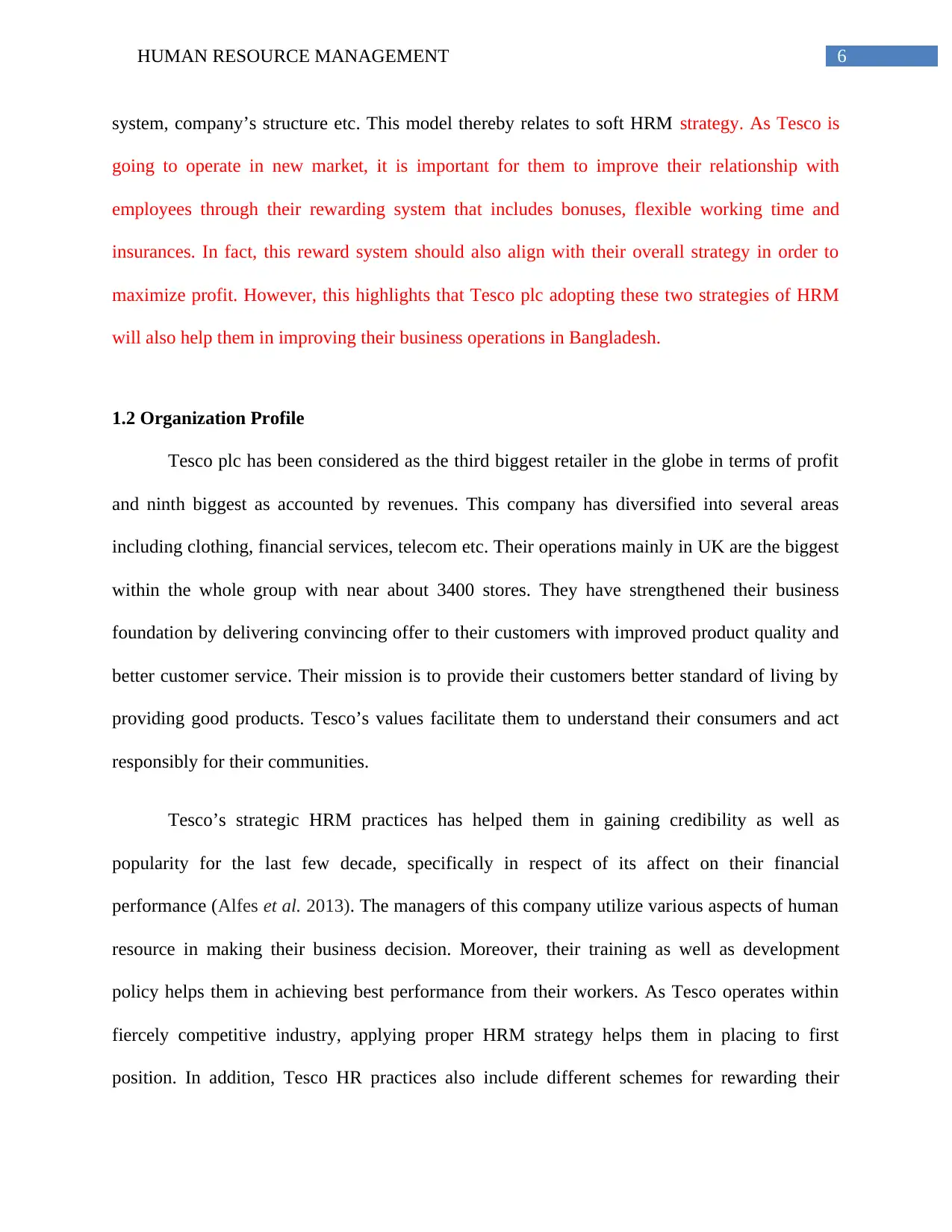
6HUMAN RESOURCE MANAGEMENT
system, company’s structure etc. This model thereby relates to soft HRM strategy. As Tesco is
going to operate in new market, it is important for them to improve their relationship with
employees through their rewarding system that includes bonuses, flexible working time and
insurances. In fact, this reward system should also align with their overall strategy in order to
maximize profit. However, this highlights that Tesco plc adopting these two strategies of HRM
will also help them in improving their business operations in Bangladesh.
1.2 Organization Profile
Tesco plc has been considered as the third biggest retailer in the globe in terms of profit
and ninth biggest as accounted by revenues. This company has diversified into several areas
including clothing, financial services, telecom etc. Their operations mainly in UK are the biggest
within the whole group with near about 3400 stores. They have strengthened their business
foundation by delivering convincing offer to their customers with improved product quality and
better customer service. Their mission is to provide their customers better standard of living by
providing good products. Tesco’s values facilitate them to understand their consumers and act
responsibly for their communities.
Tesco’s strategic HRM practices has helped them in gaining credibility as well as
popularity for the last few decade, specifically in respect of its affect on their financial
performance (Alfes et al. 2013). The managers of this company utilize various aspects of human
resource in making their business decision. Moreover, their training as well as development
policy helps them in achieving best performance from their workers. As Tesco operates within
fiercely competitive industry, applying proper HRM strategy helps them in placing to first
position. In addition, Tesco HR practices also include different schemes for rewarding their
system, company’s structure etc. This model thereby relates to soft HRM strategy. As Tesco is
going to operate in new market, it is important for them to improve their relationship with
employees through their rewarding system that includes bonuses, flexible working time and
insurances. In fact, this reward system should also align with their overall strategy in order to
maximize profit. However, this highlights that Tesco plc adopting these two strategies of HRM
will also help them in improving their business operations in Bangladesh.
1.2 Organization Profile
Tesco plc has been considered as the third biggest retailer in the globe in terms of profit
and ninth biggest as accounted by revenues. This company has diversified into several areas
including clothing, financial services, telecom etc. Their operations mainly in UK are the biggest
within the whole group with near about 3400 stores. They have strengthened their business
foundation by delivering convincing offer to their customers with improved product quality and
better customer service. Their mission is to provide their customers better standard of living by
providing good products. Tesco’s values facilitate them to understand their consumers and act
responsibly for their communities.
Tesco’s strategic HRM practices has helped them in gaining credibility as well as
popularity for the last few decade, specifically in respect of its affect on their financial
performance (Alfes et al. 2013). The managers of this company utilize various aspects of human
resource in making their business decision. Moreover, their training as well as development
policy helps them in achieving best performance from their workers. As Tesco operates within
fiercely competitive industry, applying proper HRM strategy helps them in placing to first
position. In addition, Tesco HR practices also include different schemes for rewarding their
Paraphrase This Document
Need a fresh take? Get an instant paraphrase of this document with our AI Paraphraser
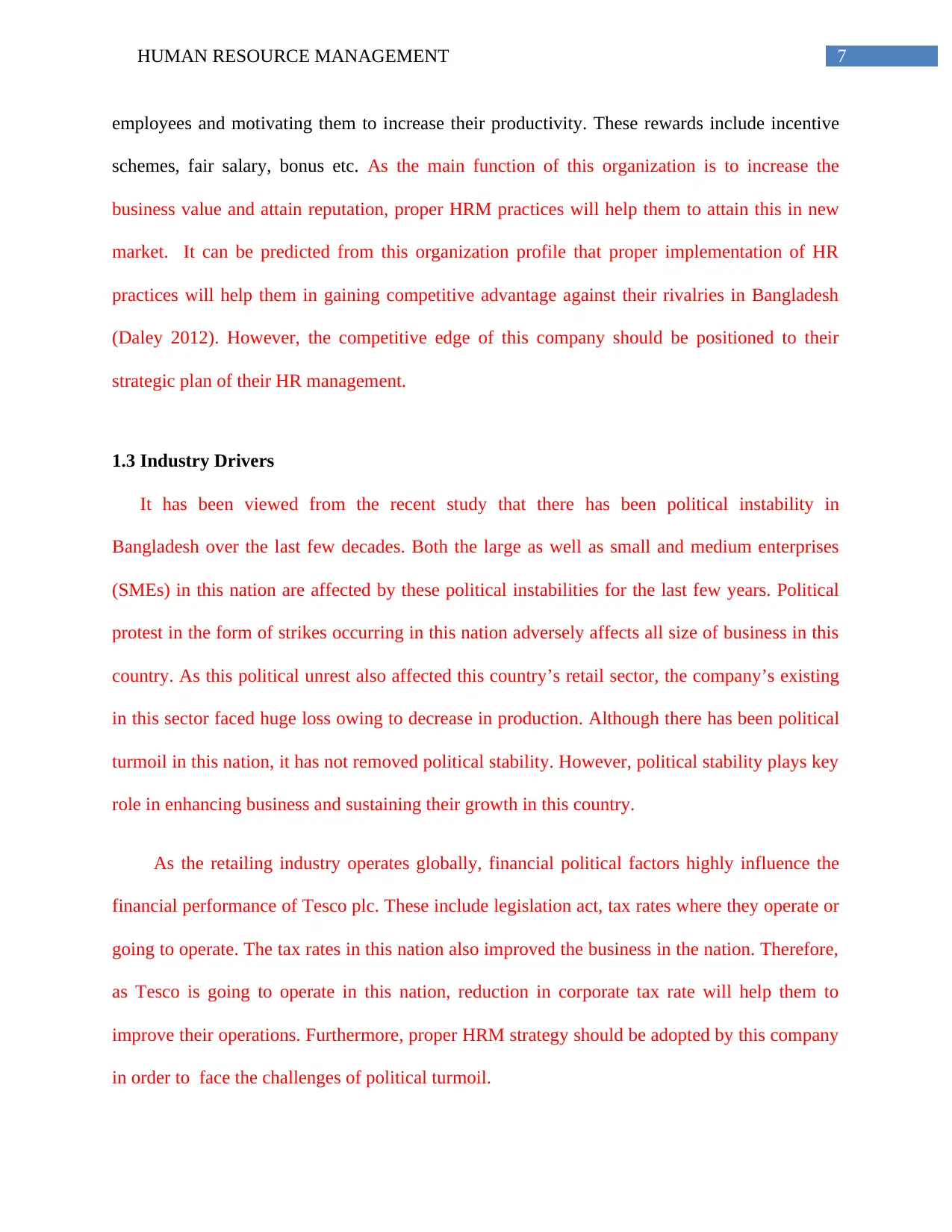
7HUMAN RESOURCE MANAGEMENT
employees and motivating them to increase their productivity. These rewards include incentive
schemes, fair salary, bonus etc. As the main function of this organization is to increase the
business value and attain reputation, proper HRM practices will help them to attain this in new
market. It can be predicted from this organization profile that proper implementation of HR
practices will help them in gaining competitive advantage against their rivalries in Bangladesh
(Daley 2012). However, the competitive edge of this company should be positioned to their
strategic plan of their HR management.
1.3 Industry Drivers
It has been viewed from the recent study that there has been political instability in
Bangladesh over the last few decades. Both the large as well as small and medium enterprises
(SMEs) in this nation are affected by these political instabilities for the last few years. Political
protest in the form of strikes occurring in this nation adversely affects all size of business in this
country. As this political unrest also affected this country’s retail sector, the company’s existing
in this sector faced huge loss owing to decrease in production. Although there has been political
turmoil in this nation, it has not removed political stability. However, political stability plays key
role in enhancing business and sustaining their growth in this country.
As the retailing industry operates globally, financial political factors highly influence the
financial performance of Tesco plc. These include legislation act, tax rates where they operate or
going to operate. The tax rates in this nation also improved the business in the nation. Therefore,
as Tesco is going to operate in this nation, reduction in corporate tax rate will help them to
improve their operations. Furthermore, proper HRM strategy should be adopted by this company
in order to face the challenges of political turmoil.
employees and motivating them to increase their productivity. These rewards include incentive
schemes, fair salary, bonus etc. As the main function of this organization is to increase the
business value and attain reputation, proper HRM practices will help them to attain this in new
market. It can be predicted from this organization profile that proper implementation of HR
practices will help them in gaining competitive advantage against their rivalries in Bangladesh
(Daley 2012). However, the competitive edge of this company should be positioned to their
strategic plan of their HR management.
1.3 Industry Drivers
It has been viewed from the recent study that there has been political instability in
Bangladesh over the last few decades. Both the large as well as small and medium enterprises
(SMEs) in this nation are affected by these political instabilities for the last few years. Political
protest in the form of strikes occurring in this nation adversely affects all size of business in this
country. As this political unrest also affected this country’s retail sector, the company’s existing
in this sector faced huge loss owing to decrease in production. Although there has been political
turmoil in this nation, it has not removed political stability. However, political stability plays key
role in enhancing business and sustaining their growth in this country.
As the retailing industry operates globally, financial political factors highly influence the
financial performance of Tesco plc. These include legislation act, tax rates where they operate or
going to operate. The tax rates in this nation also improved the business in the nation. Therefore,
as Tesco is going to operate in this nation, reduction in corporate tax rate will help them to
improve their operations. Furthermore, proper HRM strategy should be adopted by this company
in order to face the challenges of political turmoil.
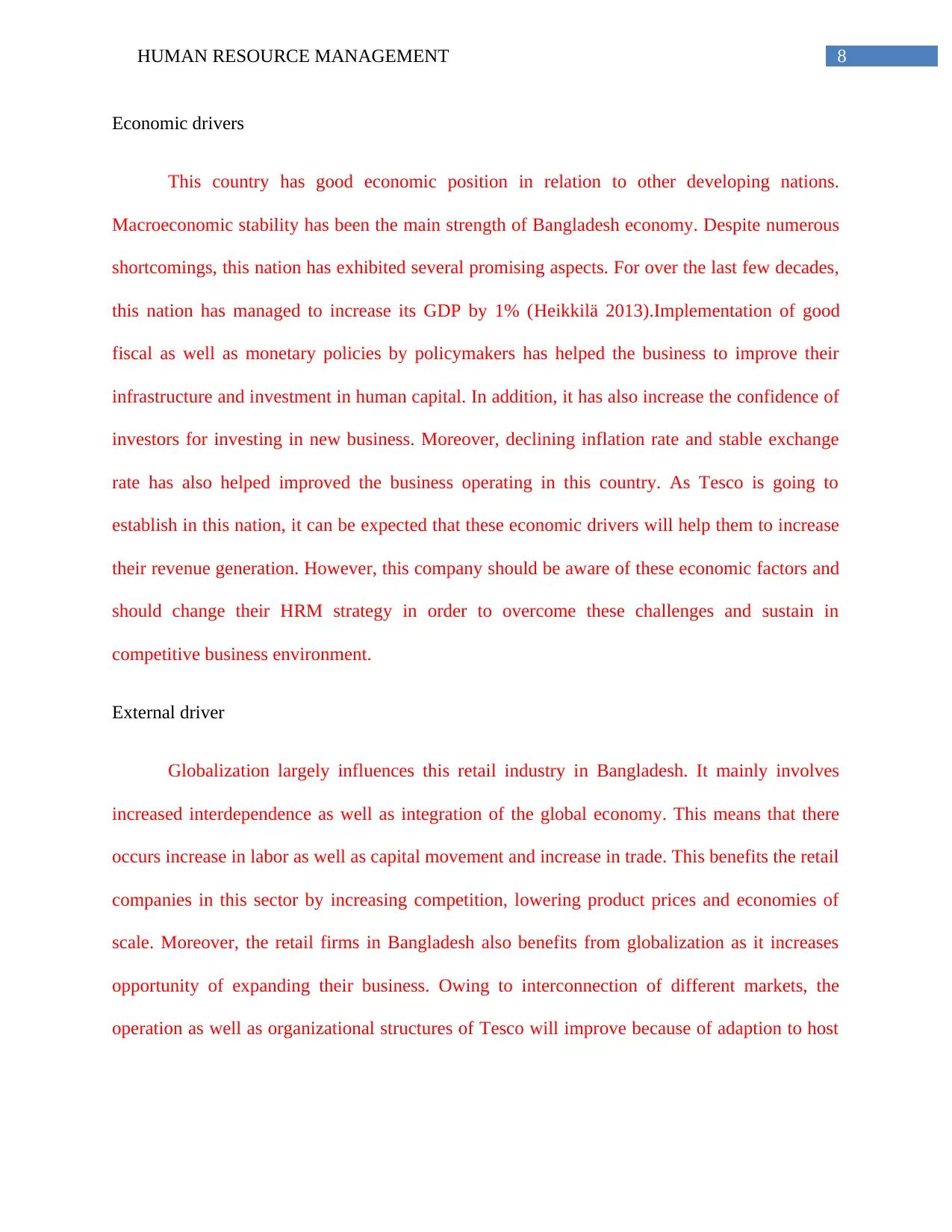
8HUMAN RESOURCE MANAGEMENT
Economic drivers
This country has good economic position in relation to other developing nations.
Macroeconomic stability has been the main strength of Bangladesh economy. Despite numerous
shortcomings, this nation has exhibited several promising aspects. For over the last few decades,
this nation has managed to increase its GDP by 1% (Heikkilä 2013).Implementation of good
fiscal as well as monetary policies by policymakers has helped the business to improve their
infrastructure and investment in human capital. In addition, it has also increase the confidence of
investors for investing in new business. Moreover, declining inflation rate and stable exchange
rate has also helped improved the business operating in this country. As Tesco is going to
establish in this nation, it can be expected that these economic drivers will help them to increase
their revenue generation. However, this company should be aware of these economic factors and
should change their HRM strategy in order to overcome these challenges and sustain in
competitive business environment.
External driver
Globalization largely influences this retail industry in Bangladesh. It mainly involves
increased interdependence as well as integration of the global economy. This means that there
occurs increase in labor as well as capital movement and increase in trade. This benefits the retail
companies in this sector by increasing competition, lowering product prices and economies of
scale. Moreover, the retail firms in Bangladesh also benefits from globalization as it increases
opportunity of expanding their business. Owing to interconnection of different markets, the
operation as well as organizational structures of Tesco will improve because of adaption to host
Economic drivers
This country has good economic position in relation to other developing nations.
Macroeconomic stability has been the main strength of Bangladesh economy. Despite numerous
shortcomings, this nation has exhibited several promising aspects. For over the last few decades,
this nation has managed to increase its GDP by 1% (Heikkilä 2013).Implementation of good
fiscal as well as monetary policies by policymakers has helped the business to improve their
infrastructure and investment in human capital. In addition, it has also increase the confidence of
investors for investing in new business. Moreover, declining inflation rate and stable exchange
rate has also helped improved the business operating in this country. As Tesco is going to
establish in this nation, it can be expected that these economic drivers will help them to increase
their revenue generation. However, this company should be aware of these economic factors and
should change their HRM strategy in order to overcome these challenges and sustain in
competitive business environment.
External driver
Globalization largely influences this retail industry in Bangladesh. It mainly involves
increased interdependence as well as integration of the global economy. This means that there
occurs increase in labor as well as capital movement and increase in trade. This benefits the retail
companies in this sector by increasing competition, lowering product prices and economies of
scale. Moreover, the retail firms in Bangladesh also benefits from globalization as it increases
opportunity of expanding their business. Owing to interconnection of different markets, the
operation as well as organizational structures of Tesco will improve because of adaption to host
⊘ This is a preview!⊘
Do you want full access?
Subscribe today to unlock all pages.

Trusted by 1+ million students worldwide
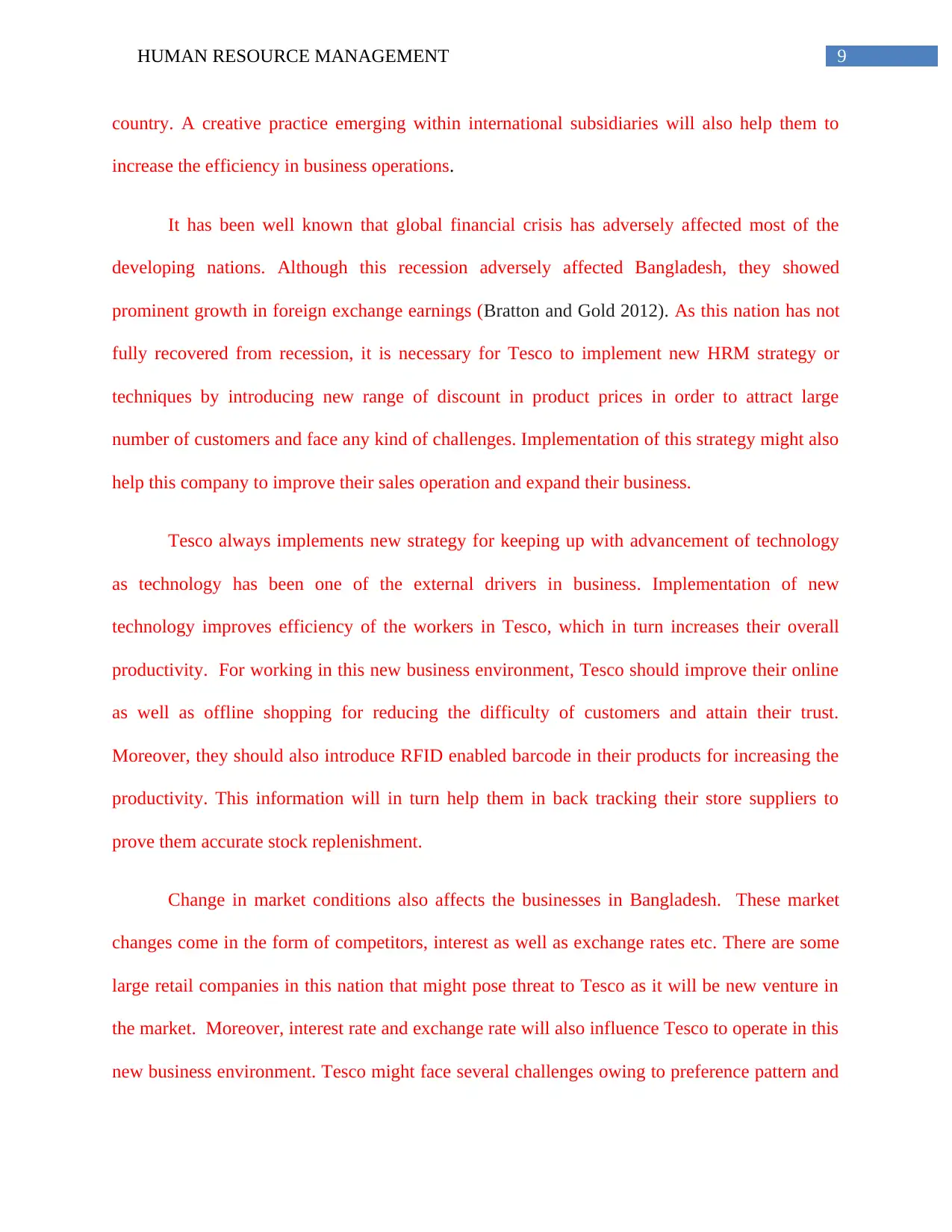
9HUMAN RESOURCE MANAGEMENT
country. A creative practice emerging within international subsidiaries will also help them to
increase the efficiency in business operations.
It has been well known that global financial crisis has adversely affected most of the
developing nations. Although this recession adversely affected Bangladesh, they showed
prominent growth in foreign exchange earnings (Bratton and Gold 2012). As this nation has not
fully recovered from recession, it is necessary for Tesco to implement new HRM strategy or
techniques by introducing new range of discount in product prices in order to attract large
number of customers and face any kind of challenges. Implementation of this strategy might also
help this company to improve their sales operation and expand their business.
Tesco always implements new strategy for keeping up with advancement of technology
as technology has been one of the external drivers in business. Implementation of new
technology improves efficiency of the workers in Tesco, which in turn increases their overall
productivity. For working in this new business environment, Tesco should improve their online
as well as offline shopping for reducing the difficulty of customers and attain their trust.
Moreover, they should also introduce RFID enabled barcode in their products for increasing the
productivity. This information will in turn help them in back tracking their store suppliers to
prove them accurate stock replenishment.
Change in market conditions also affects the businesses in Bangladesh. These market
changes come in the form of competitors, interest as well as exchange rates etc. There are some
large retail companies in this nation that might pose threat to Tesco as it will be new venture in
the market. Moreover, interest rate and exchange rate will also influence Tesco to operate in this
new business environment. Tesco might face several challenges owing to preference pattern and
country. A creative practice emerging within international subsidiaries will also help them to
increase the efficiency in business operations.
It has been well known that global financial crisis has adversely affected most of the
developing nations. Although this recession adversely affected Bangladesh, they showed
prominent growth in foreign exchange earnings (Bratton and Gold 2012). As this nation has not
fully recovered from recession, it is necessary for Tesco to implement new HRM strategy or
techniques by introducing new range of discount in product prices in order to attract large
number of customers and face any kind of challenges. Implementation of this strategy might also
help this company to improve their sales operation and expand their business.
Tesco always implements new strategy for keeping up with advancement of technology
as technology has been one of the external drivers in business. Implementation of new
technology improves efficiency of the workers in Tesco, which in turn increases their overall
productivity. For working in this new business environment, Tesco should improve their online
as well as offline shopping for reducing the difficulty of customers and attain their trust.
Moreover, they should also introduce RFID enabled barcode in their products for increasing the
productivity. This information will in turn help them in back tracking their store suppliers to
prove them accurate stock replenishment.
Change in market conditions also affects the businesses in Bangladesh. These market
changes come in the form of competitors, interest as well as exchange rates etc. There are some
large retail companies in this nation that might pose threat to Tesco as it will be new venture in
the market. Moreover, interest rate and exchange rate will also influence Tesco to operate in this
new business environment. Tesco might face several challenges owing to preference pattern and
Paraphrase This Document
Need a fresh take? Get an instant paraphrase of this document with our AI Paraphraser
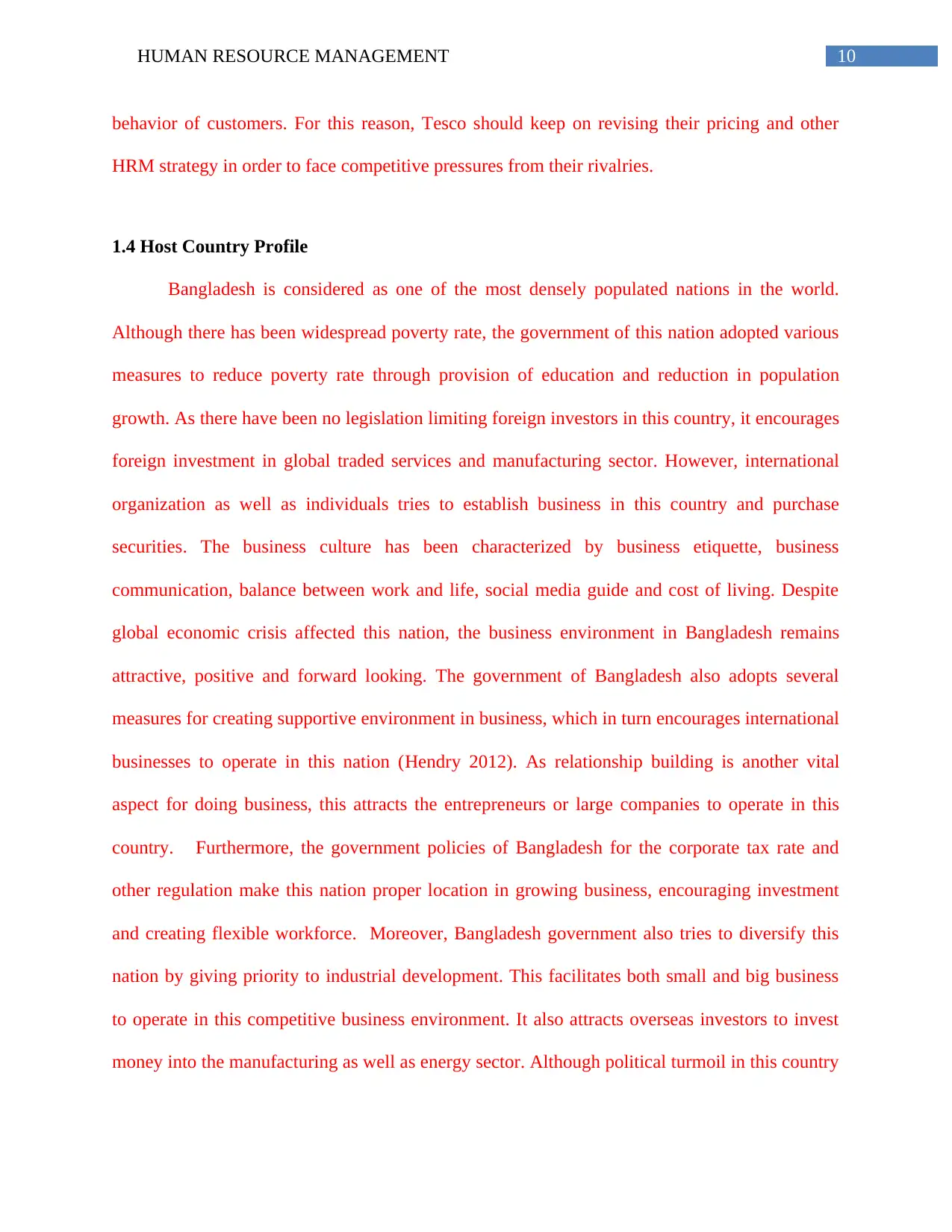
10HUMAN RESOURCE MANAGEMENT
behavior of customers. For this reason, Tesco should keep on revising their pricing and other
HRM strategy in order to face competitive pressures from their rivalries.
1.4 Host Country Profile
Bangladesh is considered as one of the most densely populated nations in the world.
Although there has been widespread poverty rate, the government of this nation adopted various
measures to reduce poverty rate through provision of education and reduction in population
growth. As there have been no legislation limiting foreign investors in this country, it encourages
foreign investment in global traded services and manufacturing sector. However, international
organization as well as individuals tries to establish business in this country and purchase
securities. The business culture has been characterized by business etiquette, business
communication, balance between work and life, social media guide and cost of living. Despite
global economic crisis affected this nation, the business environment in Bangladesh remains
attractive, positive and forward looking. The government of Bangladesh also adopts several
measures for creating supportive environment in business, which in turn encourages international
businesses to operate in this nation (Hendry 2012). As relationship building is another vital
aspect for doing business, this attracts the entrepreneurs or large companies to operate in this
country. Furthermore, the government policies of Bangladesh for the corporate tax rate and
other regulation make this nation proper location in growing business, encouraging investment
and creating flexible workforce. Moreover, Bangladesh government also tries to diversify this
nation by giving priority to industrial development. This facilitates both small and big business
to operate in this competitive business environment. It also attracts overseas investors to invest
money into the manufacturing as well as energy sector. Although political turmoil in this country
behavior of customers. For this reason, Tesco should keep on revising their pricing and other
HRM strategy in order to face competitive pressures from their rivalries.
1.4 Host Country Profile
Bangladesh is considered as one of the most densely populated nations in the world.
Although there has been widespread poverty rate, the government of this nation adopted various
measures to reduce poverty rate through provision of education and reduction in population
growth. As there have been no legislation limiting foreign investors in this country, it encourages
foreign investment in global traded services and manufacturing sector. However, international
organization as well as individuals tries to establish business in this country and purchase
securities. The business culture has been characterized by business etiquette, business
communication, balance between work and life, social media guide and cost of living. Despite
global economic crisis affected this nation, the business environment in Bangladesh remains
attractive, positive and forward looking. The government of Bangladesh also adopts several
measures for creating supportive environment in business, which in turn encourages international
businesses to operate in this nation (Hendry 2012). As relationship building is another vital
aspect for doing business, this attracts the entrepreneurs or large companies to operate in this
country. Furthermore, the government policies of Bangladesh for the corporate tax rate and
other regulation make this nation proper location in growing business, encouraging investment
and creating flexible workforce. Moreover, Bangladesh government also tries to diversify this
nation by giving priority to industrial development. This facilitates both small and big business
to operate in this competitive business environment. It also attracts overseas investors to invest
money into the manufacturing as well as energy sector. Although political turmoil in this country
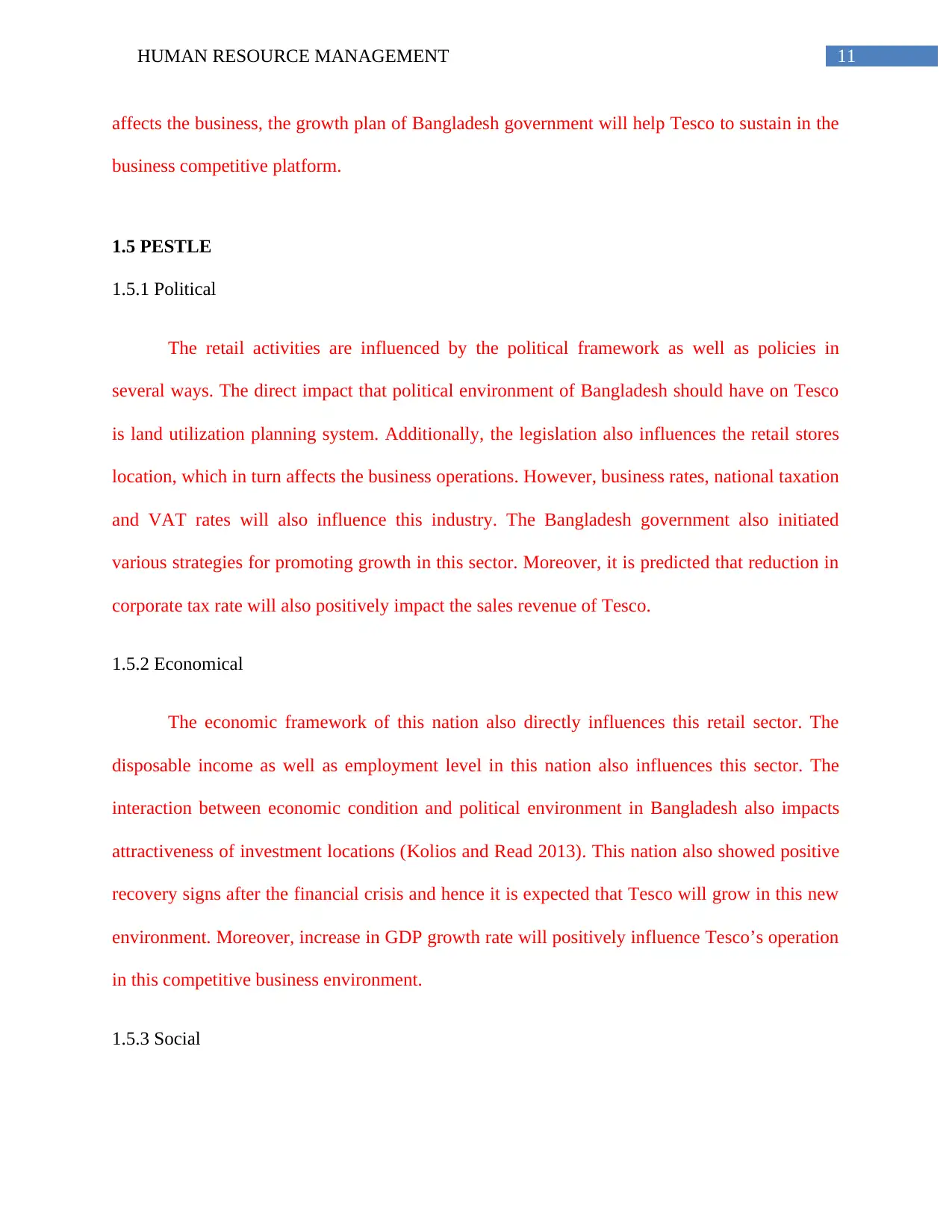
11HUMAN RESOURCE MANAGEMENT
affects the business, the growth plan of Bangladesh government will help Tesco to sustain in the
business competitive platform.
1.5 PESTLE
1.5.1 Political
The retail activities are influenced by the political framework as well as policies in
several ways. The direct impact that political environment of Bangladesh should have on Tesco
is land utilization planning system. Additionally, the legislation also influences the retail stores
location, which in turn affects the business operations. However, business rates, national taxation
and VAT rates will also influence this industry. The Bangladesh government also initiated
various strategies for promoting growth in this sector. Moreover, it is predicted that reduction in
corporate tax rate will also positively impact the sales revenue of Tesco.
1.5.2 Economical
The economic framework of this nation also directly influences this retail sector. The
disposable income as well as employment level in this nation also influences this sector. The
interaction between economic condition and political environment in Bangladesh also impacts
attractiveness of investment locations (Kolios and Read 2013). This nation also showed positive
recovery signs after the financial crisis and hence it is expected that Tesco will grow in this new
environment. Moreover, increase in GDP growth rate will positively influence Tesco’s operation
in this competitive business environment.
1.5.3 Social
affects the business, the growth plan of Bangladesh government will help Tesco to sustain in the
business competitive platform.
1.5 PESTLE
1.5.1 Political
The retail activities are influenced by the political framework as well as policies in
several ways. The direct impact that political environment of Bangladesh should have on Tesco
is land utilization planning system. Additionally, the legislation also influences the retail stores
location, which in turn affects the business operations. However, business rates, national taxation
and VAT rates will also influence this industry. The Bangladesh government also initiated
various strategies for promoting growth in this sector. Moreover, it is predicted that reduction in
corporate tax rate will also positively impact the sales revenue of Tesco.
1.5.2 Economical
The economic framework of this nation also directly influences this retail sector. The
disposable income as well as employment level in this nation also influences this sector. The
interaction between economic condition and political environment in Bangladesh also impacts
attractiveness of investment locations (Kolios and Read 2013). This nation also showed positive
recovery signs after the financial crisis and hence it is expected that Tesco will grow in this new
environment. Moreover, increase in GDP growth rate will positively influence Tesco’s operation
in this competitive business environment.
1.5.3 Social
⊘ This is a preview!⊘
Do you want full access?
Subscribe today to unlock all pages.

Trusted by 1+ million students worldwide
1 out of 25
Related Documents
Your All-in-One AI-Powered Toolkit for Academic Success.
+13062052269
info@desklib.com
Available 24*7 on WhatsApp / Email
![[object Object]](/_next/static/media/star-bottom.7253800d.svg)
Unlock your academic potential
Copyright © 2020–2025 A2Z Services. All Rights Reserved. Developed and managed by ZUCOL.





